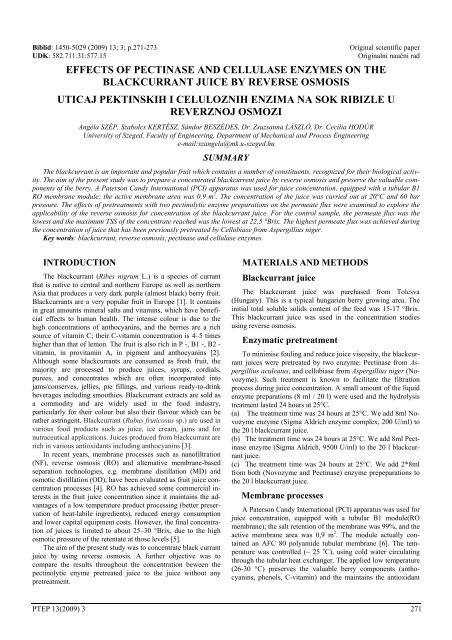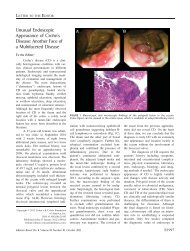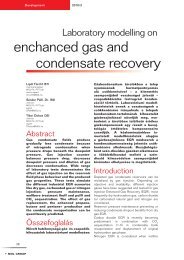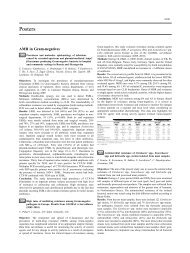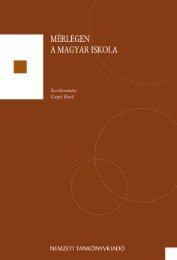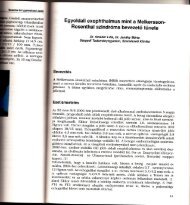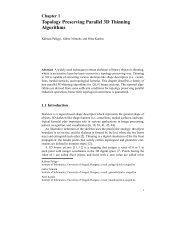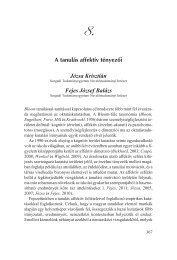effects of pectinase and cellulase enzymes on the ... - Publicatio
effects of pectinase and cellulase enzymes on the ... - Publicatio
effects of pectinase and cellulase enzymes on the ... - Publicatio
Create successful ePaper yourself
Turn your PDF publications into a flip-book with our unique Google optimized e-Paper software.
Biblid: 1450-5029 (2009) 13; 3; p.271-273 Original scientific paper<br />
UDK: 582.711.31:577.15 Originalni naučni rad<br />
EFFECTS OF PECTINASE AND CELLULASE ENZYMES ON THE<br />
BLACKCURRANT JUICE BY REVERSE OSMOSIS<br />
UTICAJ PEKTINSKIH I CELULOZNIH ENZIMA NA SOK RIBIZLE U<br />
REVERZNOJ OSMOZI<br />
Angéla SZÉP, Szabolcs KERTÉSZ, Sándor BESZÉDES, Dr. Zsuzsanna LÁSZLÓ, Dr. Cecilia HODÚR<br />
University <str<strong>on</strong>g>of</str<strong>on</strong>g> Szeged, Faculty <str<strong>on</strong>g>of</str<strong>on</strong>g> Engineering, Department <str<strong>on</strong>g>of</str<strong>on</strong>g> Mechanical <str<strong>on</strong>g>and</str<strong>on</strong>g> Process Engineering<br />
e-mail:szangela@mk.u-szeged.hu<br />
SUMMARY<br />
The blackcurrant is an important <str<strong>on</strong>g>and</str<strong>on</strong>g> popular fruit which c<strong>on</strong>tains a number <str<strong>on</strong>g>of</str<strong>on</strong>g> c<strong>on</strong>stituents, recognized for <strong>the</strong>ir biological activity.<br />
Τhe aim <str<strong>on</strong>g>of</str<strong>on</strong>g> <strong>the</strong> present study was to prepare a c<strong>on</strong>centrated blackcurrent juice by reverse osmosis <str<strong>on</strong>g>and</str<strong>on</strong>g> preserve <strong>the</strong> valuable comp<strong>on</strong>ents<br />
<str<strong>on</strong>g>of</str<strong>on</strong>g> <strong>the</strong> berry. Α Paters<strong>on</strong> C<str<strong>on</strong>g>and</str<strong>on</strong>g>y Internati<strong>on</strong>al (PCI) apparatus was used for juice c<strong>on</strong>centrati<strong>on</strong>, equipped with a tubular B1<br />
RO membrane module; <strong>the</strong> active membrane area was 0,9 m 2 . The c<strong>on</strong>centrati<strong>on</strong> <str<strong>on</strong>g>of</str<strong>on</strong>g> <strong>the</strong> juice was carried out at 20°C <str<strong>on</strong>g>and</str<strong>on</strong>g> 60 bar<br />
pressure. The <str<strong>on</strong>g>effects</str<strong>on</strong>g> <str<strong>on</strong>g>of</str<strong>on</strong>g> pretreatments with two pectinolytic enzyme preparati<strong>on</strong>s <strong>on</strong> <strong>the</strong> permeate flux were examined to explore <strong>the</strong><br />
applicability <str<strong>on</strong>g>of</str<strong>on</strong>g> <strong>the</strong> reverse osmosis for c<strong>on</strong>centrati<strong>on</strong> <str<strong>on</strong>g>of</str<strong>on</strong>g> <strong>the</strong> blackcurrant juice. For <strong>the</strong> c<strong>on</strong>trol sample, <strong>the</strong> permeate flux was <strong>the</strong><br />
lowest <str<strong>on</strong>g>and</str<strong>on</strong>g> <strong>the</strong> maximum TSS <str<strong>on</strong>g>of</str<strong>on</strong>g> <strong>the</strong> c<strong>on</strong>centrate reached was <strong>the</strong> lowest at 22,5 °Brix. The highest permeate flux was achieved during<br />
<strong>the</strong> c<strong>on</strong>centrati<strong>on</strong> <str<strong>on</strong>g>of</str<strong>on</strong>g> juice that has been previously pretreated by Cellobiase from Aspergillius niger.<br />
Key words: blackcurrant, reverse osmosis, <str<strong>on</strong>g>pectinase</str<strong>on</strong>g> <str<strong>on</strong>g>and</str<strong>on</strong>g> <str<strong>on</strong>g>cellulase</str<strong>on</strong>g> <str<strong>on</strong>g>enzymes</str<strong>on</strong>g>.<br />
INTRODUCTION<br />
The blackcurrant (Ribes nigrum L.) is a species <str<strong>on</strong>g>of</str<strong>on</strong>g> currant<br />
that is native to central <str<strong>on</strong>g>and</str<strong>on</strong>g> nor<strong>the</strong>rn Europe as well as nor<strong>the</strong>rn<br />
Asia that produces a very dark purple (almost black) berry fruit.<br />
Blackcurrants are a very popular fruit in Europe [1]. It c<strong>on</strong>tains<br />
in great amounts mineral salts <str<strong>on</strong>g>and</str<strong>on</strong>g> vitamins, which have beneficial<br />
<str<strong>on</strong>g>effects</str<strong>on</strong>g> to human health. The intense colour is due to <strong>the</strong><br />
high c<strong>on</strong>centrati<strong>on</strong>s <str<strong>on</strong>g>of</str<strong>on</strong>g> anthocyanins, <str<strong>on</strong>g>and</str<strong>on</strong>g> <strong>the</strong> berries are a rich<br />
source <str<strong>on</strong>g>of</str<strong>on</strong>g> vitamin C; <strong>the</strong>ir C-vitamin c<strong>on</strong>centrati<strong>on</strong> is 4–5 times<br />
higher than that <str<strong>on</strong>g>of</str<strong>on</strong>g> lem<strong>on</strong>. The fruit is also rich in P -, B1 -, B2 -<br />
vitamin, in provitamin A, in pigment <str<strong>on</strong>g>and</str<strong>on</strong>g> anthocyanins [2].<br />
Although some blackcurrants are c<strong>on</strong>sumed as fresh fruit, <strong>the</strong><br />
majority are processed to produce juices, syrups, cordials,<br />
purees, <str<strong>on</strong>g>and</str<strong>on</strong>g> c<strong>on</strong>centrates which are <str<strong>on</strong>g>of</str<strong>on</strong>g>ten incorporated into<br />
jams/c<strong>on</strong>serves, jellies, pie fillings, <str<strong>on</strong>g>and</str<strong>on</strong>g> various ready-to-drink<br />
beverages including smoothies. Blackcurrant extracts are sold as<br />
a commodity <str<strong>on</strong>g>and</str<strong>on</strong>g> are widely used in <strong>the</strong> food industry,<br />
particularly for <strong>the</strong>ir colour but also <strong>the</strong>ir flavour which can be<br />
ra<strong>the</strong>r astringent. Blackcurrant (Rubus fruticosus sp.) are used in<br />
various food products such as juice, ice cream, jams <str<strong>on</strong>g>and</str<strong>on</strong>g> for<br />
nutraceutical applicati<strong>on</strong>s. Juices produced from blackcurrant are<br />
rich in various antioxidants including anthocyanins [3].<br />
In recent years, membrane processes such as nan<str<strong>on</strong>g>of</str<strong>on</strong>g>iltrati<strong>on</strong><br />
(NF), reverse osmosis (RO) <str<strong>on</strong>g>and</str<strong>on</strong>g> alternative membrane-based<br />
separati<strong>on</strong> technologies, e.g. membrane distillati<strong>on</strong> (MD) <str<strong>on</strong>g>and</str<strong>on</strong>g><br />
osmotic distillati<strong>on</strong> (OD), have been evaluated as fruit juice c<strong>on</strong>centrati<strong>on</strong><br />
processes [4]. RO has achieved some commercial interests<br />
in <strong>the</strong> fruit juice c<strong>on</strong>centrati<strong>on</strong> since it maintains <strong>the</strong> advantages<br />
<str<strong>on</strong>g>of</str<strong>on</strong>g> a low temperature product processing (better preservati<strong>on</strong><br />
<str<strong>on</strong>g>of</str<strong>on</strong>g> heat-labile ingredients), reduced energy c<strong>on</strong>sumpti<strong>on</strong><br />
<str<strong>on</strong>g>and</str<strong>on</strong>g> lower capital equipment costs. However, <strong>the</strong> final c<strong>on</strong>centrati<strong>on</strong><br />
<str<strong>on</strong>g>of</str<strong>on</strong>g> juices is limited to about 25–30 °Brix, due to <strong>the</strong> high<br />
osmotic pressure <str<strong>on</strong>g>of</str<strong>on</strong>g> <strong>the</strong> retentate at those levels [5].<br />
The aim <str<strong>on</strong>g>of</str<strong>on</strong>g> <strong>the</strong> present study was to c<strong>on</strong>centrate black currant<br />
juice by using reverse osmosis. A fur<strong>the</strong>r objective was to<br />
compare <strong>the</strong> results throughout <strong>the</strong> c<strong>on</strong>centrati<strong>on</strong> beween <strong>the</strong><br />
pectinolytic enyme pretreated juice to <strong>the</strong> juice without any<br />
pretreatment.<br />
MATERIALS AND METHODS<br />
Blackcurrant juice<br />
The blackcurrant juice was purchased from Tolcsva<br />
(Hungary). This is a typical hungarien berry growing area. The<br />
initial total soluble solids c<strong>on</strong>tent <str<strong>on</strong>g>of</str<strong>on</strong>g> <strong>the</strong> feed was 15-17 °Brix.<br />
This blackcurrant juice was used in <strong>the</strong> c<strong>on</strong>centrati<strong>on</strong> studies<br />
using reverse osmosis.<br />
Enzymatic pretreatment<br />
To minimise fouling <str<strong>on</strong>g>and</str<strong>on</strong>g> reduce juice viscosity, <strong>the</strong> blackcurrant<br />
juices were pretreated by two enzyme: Pectinase from Aspergillius<br />
aculeatus, <str<strong>on</strong>g>and</str<strong>on</strong>g> cellobiase from Aspergillius niger (Novozyme).<br />
Such treatment is known to facilitate <strong>the</strong> filtrati<strong>on</strong><br />
process during juice c<strong>on</strong>centrati<strong>on</strong>. A small amount <str<strong>on</strong>g>of</str<strong>on</strong>g> <strong>the</strong> liquid<br />
enzyme preparati<strong>on</strong>s (8 ml / 20 l) were used <str<strong>on</strong>g>and</str<strong>on</strong>g> <strong>the</strong> hydrolysis<br />
treatment lasted 24 hours at 25°C.<br />
(a) The treatment time was 24 hours at 25°C. We add 8ml Novozyme<br />
enzyme (Sigma Aldrich enzyme complex, 200 U/ml) to<br />
<strong>the</strong> 20 l blackcurrant juice.<br />
(b) The treatment time was 24 hours at 25°C. We add 8ml Pectinase<br />
enzyme (Sigma Aldrich, 9500 U/ml) to <strong>the</strong> 20 l blackcurrant<br />
juice.<br />
(c) The treatment time was 24 hours at 25°C. We add 2*8ml<br />
from both (Novozyme <str<strong>on</strong>g>and</str<strong>on</strong>g> Pectinase) enzyme prepeparati<strong>on</strong>s to<br />
<strong>the</strong> 20 l blackcurrant juice.<br />
Membrane processes<br />
A Paters<strong>on</strong> C<str<strong>on</strong>g>and</str<strong>on</strong>g>y Internati<strong>on</strong>al (PCI) apparatus was used for<br />
juice c<strong>on</strong>centrati<strong>on</strong>, equipped with a tubular B1 module(RO<br />
membrane); <strong>the</strong> salt retenti<strong>on</strong> <str<strong>on</strong>g>of</str<strong>on</strong>g> <strong>the</strong> membrane was 99%, <str<strong>on</strong>g>and</str<strong>on</strong>g> <strong>the</strong><br />
active membrane area was 0,9 m 2 . The module actually c<strong>on</strong>tained<br />
an AFC 80 polyamide tubular membrane [6]. The temperature<br />
was c<strong>on</strong>trolled (~ 25 o C), using cold water circulating<br />
through <strong>the</strong> tubular heat exchanger. The applied low temperature<br />
(26-30 °C) preserves <strong>the</strong> valuable berry comp<strong>on</strong>ents (anthocyanins,<br />
phenols, C-vitamin) <str<strong>on</strong>g>and</str<strong>on</strong>g> <strong>the</strong> maintains <strong>the</strong> antioxidant<br />
PTEP 13(2009) 3 271
capacity <str<strong>on</strong>g>of</str<strong>on</strong>g> <strong>the</strong> juice throughout <strong>the</strong> process. The transmembrane<br />
pressure was fixed at 60 bar, <str<strong>on</strong>g>and</str<strong>on</strong>g> 60 liter <str<strong>on</strong>g>of</str<strong>on</strong>g> <strong>the</strong> juices were c<strong>on</strong>centrated<br />
in each batch. Before <str<strong>on</strong>g>and</str<strong>on</strong>g> after each experiment, <strong>the</strong><br />
water flux was measured with destilled water at 25 ◦ C. Membrane<br />
regenerati<strong>on</strong> was achieved by washing in a 0.1 w/w%<br />
NaOH soluti<strong>on</strong> <str<strong>on</strong>g>and</str<strong>on</strong>g> rinsing with distilled water. Finally, a 0.5%<br />
citric acid soluti<strong>on</strong> has been used <str<strong>on</strong>g>and</str<strong>on</strong>g> circulated for 30 min, followed<br />
by rinsing <str<strong>on</strong>g>of</str<strong>on</strong>g> <strong>the</strong> membrane with distilled water. A typical<br />
industrial cleaning procedure is carried out <str<strong>on</strong>g>and</str<strong>on</strong>g> followed by ano<strong>the</strong>r<br />
determinati<strong>on</strong> <str<strong>on</strong>g>of</str<strong>on</strong>g> <strong>the</strong> clean membrane resistance:<br />
J<br />
Δp<br />
TM<br />
W = (1)<br />
ηW<br />
⋅ R M<br />
where J is <strong>the</strong> permeate flux rate (m s −1 ) <str<strong>on</strong>g>and</str<strong>on</strong>g> Δ p is <strong>the</strong><br />
TM<br />
transmembrane pressure (Pa). The resistance <str<strong>on</strong>g>of</str<strong>on</strong>g> <strong>the</strong> membrane<br />
(RM) was calculated from <strong>the</strong> flux using:<br />
ΔpTM<br />
RM<br />
= (2)<br />
η ⋅ J<br />
W<br />
W<br />
where η W is <strong>the</strong> dynamic viscosity <str<strong>on</strong>g>of</str<strong>on</strong>g> water (Pa s).<br />
The fouling resistance (RF) calculated from <strong>the</strong> flux <str<strong>on</strong>g>of</str<strong>on</strong>g> <strong>the</strong><br />
clear water measured after juice c<strong>on</strong>centrati<strong>on</strong> <str<strong>on</strong>g>and</str<strong>on</strong>g> following gel<br />
layer removal:<br />
R<br />
Δp<br />
TM<br />
F = (3)<br />
J F ∗ ηW<br />
The gel-layer resistance (RG) calculated from <strong>the</strong> measured<br />
flux at <strong>the</strong> end <str<strong>on</strong>g>of</str<strong>on</strong>g> <strong>the</strong> juice c<strong>on</strong>centrati<strong>on</strong> process:<br />
Δp<br />
= R<br />
(4)<br />
TM<br />
R G − R M −<br />
J F ∗ ηm<br />
F<br />
where ηm is <strong>the</strong> viscisity <str<strong>on</strong>g>of</str<strong>on</strong>g> <strong>the</strong> blackcurrant juice at <strong>the</strong> end<br />
<str<strong>on</strong>g>of</str<strong>on</strong>g> <strong>the</strong> c<strong>on</strong>centrati<strong>on</strong> process [7].<br />
The total resistance (R T) is calculated as:<br />
R T = R M + R F + R<br />
(5)<br />
G<br />
where RT is <strong>the</strong> total resistance, RM is <strong>the</strong> membrane resistance,<br />
RF is <strong>the</strong> fouling resistance, <str<strong>on</strong>g>and</str<strong>on</strong>g> RG is <strong>the</strong> gel-layer resistance[8].<br />
Total soluble solids (TSS) c<strong>on</strong>tent was measured using an<br />
Atago PR-101α digital refractometer; <strong>the</strong> TSS data were expressed<br />
as °Brix.<br />
RESULTS AND DISCUSSION<br />
The effect <str<strong>on</strong>g>of</str<strong>on</strong>g> <strong>the</strong> transmembrane pressure (TMP) <str<strong>on</strong>g>and</str<strong>on</strong>g> <strong>the</strong> applied<br />
pretreatment <strong>on</strong> <strong>the</strong> permeate flux was investigated before<br />
<strong>the</strong> c<strong>on</strong>centrati<strong>on</strong> tests. The initial fluxes <str<strong>on</strong>g>and</str<strong>on</strong>g> <strong>the</strong> slope <str<strong>on</strong>g>of</str<strong>on</strong>g> <strong>the</strong>se<br />
changes were different <str<strong>on</strong>g>and</str<strong>on</strong>g> depended <strong>on</strong> <strong>the</strong> applied pretreatment<br />
(Fig. 1).<br />
With increasing TMP <strong>the</strong> permeate flux increased substantially.<br />
The highest permeate flux was achieved during c<strong>on</strong>centrati<strong>on</strong><br />
<str<strong>on</strong>g>of</str<strong>on</strong>g> juice previously treated by cellobiase from Aspergillius<br />
niger (Novozyme). A lower permeate flux was achieved with <strong>the</strong><br />
c<strong>on</strong>trol sample to which no enzymatic pretreatment was applied.<br />
However, <strong>the</strong> lowest permeate flux was achieved with <strong>the</strong> sample<br />
to which both <str<strong>on</strong>g>enzymes</str<strong>on</strong>g> have been applied. At 30 bar pressure,<br />
<strong>on</strong>ly <strong>the</strong> cellobiase treated blackcurrant juice provided<br />
measurable flux data, because <strong>the</strong> viscosity values <str<strong>on</strong>g>of</str<strong>on</strong>g> <strong>the</strong> cellobiase<br />
treated samples decreased better than all o<strong>the</strong>r samples. Apparently,<br />
<strong>the</strong> largest viscosity value was noticed with <strong>the</strong> juice<br />
sample treated with both <str<strong>on</strong>g>enzymes</str<strong>on</strong>g> (Table 1).<br />
J [l/m<br />
25<br />
2 h]<br />
272 PTEP 13(2009) 3<br />
20<br />
15<br />
10<br />
5<br />
0<br />
20 30 40 50 60 70<br />
TMP [bar]<br />
Novozym Pectinase 2 <str<strong>on</strong>g>enzymes</str<strong>on</strong>g> toge<strong>the</strong>r K<strong>on</strong>trol<br />
Fig. 1. The fluxes <str<strong>on</strong>g>of</str<strong>on</strong>g> <strong>the</strong> different pretreated blackcurrant <strong>on</strong> different<br />
pressure<br />
Sl. 1. Fluks različitih predtretmana crne ribizle na različitim pritiscima<br />
Table 1.Viscosity values <str<strong>on</strong>g>of</str<strong>on</strong>g> blackcurrant juice<br />
Tabela 1. Vrednosti viskoziteta soka od crne ribizle<br />
Temp. (25 °C) Novozyme<br />
The 2 <str<strong>on</strong>g>enzymes</str<strong>on</strong>g><br />
Pectinase C<strong>on</strong>trol<br />
toge<strong>the</strong>r<br />
Viscosity(mPas) 1.61 1.84 2.20 1.82<br />
The initial total soluble solids c<strong>on</strong>tent <str<strong>on</strong>g>of</str<strong>on</strong>g> <strong>the</strong> feed varied between<br />
15-17 <str<strong>on</strong>g>and</str<strong>on</strong>g> reached 26,5 °Brix for Pectinase, 29,5 °Brix for<br />
Novozyme enzyme after, 28,5 °Brix for <strong>the</strong> dual enzyme treatment<br />
<str<strong>on</strong>g>and</str<strong>on</strong>g> 22°Brix for <strong>the</strong> c<strong>on</strong>trol juice. The c<strong>on</strong>centrati<strong>on</strong> <str<strong>on</strong>g>of</str<strong>on</strong>g> <strong>the</strong><br />
c<strong>on</strong>trol sample ended after 130 minutes, whereas <strong>the</strong> c<strong>on</strong>tentrati<strong>on</strong><br />
<str<strong>on</strong>g>of</str<strong>on</strong>g> <strong>the</strong> enzyme treated samples ended after 200 minutes for<br />
Novosyme, 160 minutes for Pectinase <str<strong>on</strong>g>and</str<strong>on</strong>g> 270 minutes for <strong>the</strong><br />
dual enzyme treatment. The c<strong>on</strong>centrati<strong>on</strong> time <str<strong>on</strong>g>of</str<strong>on</strong>g> toge<strong>the</strong>r with<br />
two <str<strong>on</strong>g>enzymes</str<strong>on</strong>g> treated juices was l<strong>on</strong>ger than that <str<strong>on</strong>g>of</str<strong>on</strong>g> <strong>the</strong> Novozyme.<br />
It have a shrewd idea that <strong>the</strong> two <str<strong>on</strong>g>enzymes</str<strong>on</strong>g> entered into<br />
an interacti<strong>on</strong> with each o<strong>the</strong>r. The TSS increase was <strong>the</strong> sharpest<br />
for <strong>the</strong> Novozyme-treated sample. The latter treatment also<br />
yielded <strong>the</strong> highest TSS level (29.5 o Brix).<br />
TSS [°Brix]<br />
31<br />
29<br />
27<br />
25<br />
23<br />
21<br />
19<br />
17<br />
15<br />
Novozyme<br />
Pectinase<br />
2 <str<strong>on</strong>g>enzymes</str<strong>on</strong>g><br />
toge<strong>the</strong>r<br />
K<strong>on</strong>trol<br />
0 50 100 150 200 250 300<br />
Idő [perc]<br />
Fig. 2. Comparis<strong>on</strong> <str<strong>on</strong>g>of</str<strong>on</strong>g> TSS values during c<strong>on</strong>centrati<strong>on</strong> <str<strong>on</strong>g>of</str<strong>on</strong>g> blackcurrant<br />
juice<br />
Sl. 2. Poređenje TSS vrednosti tokom ugušćavanja soka od crne<br />
ribizle<br />
The resistance values (RM, RT, RF, <str<strong>on</strong>g>and</str<strong>on</strong>g> RG), <str<strong>on</strong>g>of</str<strong>on</strong>g> <strong>the</strong> filtrati<strong>on</strong><br />
proecess are presented in Figure 3. The fouling resistance is<br />
elevated for <strong>the</strong> Novozyme-treated sample, while <strong>the</strong> gel-layer<br />
resistance is raised in <strong>the</strong> case <str<strong>on</strong>g>of</str<strong>on</strong>g> <strong>the</strong> o<strong>the</strong>r two enzymaticallytreated<br />
samples, since <strong>the</strong> cellobiase preparati<strong>on</strong> degrades more<br />
effectively <strong>the</strong> cell wall materials <str<strong>on</strong>g>and</str<strong>on</strong>g> reduces <strong>the</strong> viscosity <str<strong>on</strong>g>of</str<strong>on</strong>g><br />
<strong>the</strong> blackcurrant juices better than <strong>the</strong> <str<strong>on</strong>g>pectinase</str<strong>on</strong>g> preparati<strong>on</strong>.
1.6E+15<br />
1.4E+15<br />
1.2E+15<br />
1.0E+15<br />
8.0E+14<br />
6.0E+14<br />
4.0E+14<br />
2.0E+14<br />
0.0E+00<br />
RT RM RF RG<br />
Novozyme Pectinase 2 <str<strong>on</strong>g>enzymes</str<strong>on</strong>g> toge<strong>the</strong>r<br />
Fig. 3. A comparis<strong>on</strong> <str<strong>on</strong>g>of</str<strong>on</strong>g> <strong>the</strong> resistance values am<strong>on</strong>g enzymztically-pretreated<br />
blackcurrant juices<br />
Sl. 3. Poređenje rezistentne vrednosti između enzimski predtretiranog<br />
soka od crne ribizle<br />
CONCLUSIONS<br />
The aim <str<strong>on</strong>g>of</str<strong>on</strong>g> this study was to examine <strong>the</strong> applicability <str<strong>on</strong>g>of</str<strong>on</strong>g> reverse<br />
osmosis for <strong>the</strong> c<strong>on</strong>centrati<strong>on</strong> <str<strong>on</strong>g>of</str<strong>on</strong>g> blackcurrant juice using<br />
an AFC 80 polyamide tubular membrane. The <str<strong>on</strong>g>effects</str<strong>on</strong>g> <str<strong>on</strong>g>of</str<strong>on</strong>g> pretreatment<br />
with different hydrolytic <str<strong>on</strong>g>enzymes</str<strong>on</strong>g> have been also explored.<br />
Two commercially available enzyme preparati<strong>on</strong>s (Pectinase<br />
from Aspergillius Aculeatus, Cellobiase from Aspergillius<br />
niger) were used in this respect, <str<strong>on</strong>g>and</str<strong>on</strong>g> <strong>the</strong> results were compared<br />
to <strong>the</strong> c<strong>on</strong>trol sample (untreated juice).<br />
For <strong>the</strong> c<strong>on</strong>trol sample, <strong>the</strong> permeate flux was <strong>the</strong> lowest, <strong>the</strong><br />
flux decline rate <strong>the</strong> highest <str<strong>on</strong>g>and</str<strong>on</strong>g> <strong>the</strong> maximum TSS <str<strong>on</strong>g>of</str<strong>on</strong>g> <strong>the</strong> c<strong>on</strong>centrate<br />
reached was at 22 °Brix. The highest permeate flux was<br />
achieved during <strong>the</strong> c<strong>on</strong>centrati<strong>on</strong> <str<strong>on</strong>g>of</str<strong>on</strong>g> juice that has been previously<br />
pretreated by Novozyme, <str<strong>on</strong>g>and</str<strong>on</strong>g> <strong>the</strong> flux decline rate was <strong>the</strong><br />
smallest for this sample as well. The highest c<strong>on</strong>centrati<strong>on</strong> ratio<br />
was observed in <strong>the</strong> case <str<strong>on</strong>g>of</str<strong>on</strong>g> <strong>the</strong> Novozyme-treated juice.<br />
It can be c<strong>on</strong>cluded that reverse osmosis is a viable method<br />
for c<strong>on</strong>centrati<strong>on</strong> <str<strong>on</strong>g>of</str<strong>on</strong>g> blackcurrant juices with <strong>the</strong> applied transmembrane<br />
pressure at 60 bar <str<strong>on</strong>g>and</str<strong>on</strong>g> 25°C operating temperature,<br />
when an enzymatic pretreatment is used before <strong>the</strong> processing. It<br />
was also found that <strong>the</strong> juice treated with Novozyme was <strong>the</strong><br />
most effectively c<strong>on</strong>cnetrated by reverse osmosis.<br />
REFERENCES<br />
[1] Wendy Holl<str<strong>on</strong>g>and</str<strong>on</strong>g>s, Gary M. Brett, Pauline Radreau, Shikha<br />
Saha, Birgit Teucher, Richard N. Bennett, Paul A. Kro<strong>on</strong>:<br />
Processing blackcurrants dramatically reduces <strong>the</strong> c<strong>on</strong>tent<br />
<str<strong>on</strong>g>and</str<strong>on</strong>g> does not enhance <strong>the</strong> urinary yield <str<strong>on</strong>g>of</str<strong>on</strong>g> anthocyanins in<br />
human subjects, Food Chemistry, Volume 108, Issue 3, 1<br />
June (2008), pp 869-878.<br />
[2] Sz. Bánvölgyi, Sz. Horváth, E. Békássy-Molnár, Gy. Vatai:<br />
C<strong>on</strong>centrati<strong>on</strong> <str<strong>on</strong>g>of</str<strong>on</strong>g> blackcurrant (Ribes nigrum L.) juice with<br />
nan<str<strong>on</strong>g>of</str<strong>on</strong>g>iltrati<strong>on</strong>, Desalinati<strong>on</strong> 200, (2006), pp 535-536.<br />
[3] Pap, M. Mahosenaho, E. P<strong>on</strong>gracz, H. Mikk<strong>on</strong>en, M. Mannila,<br />
V. Virtanen, L. Myllykoski <str<strong>on</strong>g>and</str<strong>on</strong>g> R. L. Keiski: Utilizati<strong>on</strong><br />
<str<strong>on</strong>g>of</str<strong>on</strong>g> Ultrafiltrati<strong>on</strong> <str<strong>on</strong>g>and</str<strong>on</strong>g> Reverse Osmosis in Cranberry<br />
<str<strong>on</strong>g>and</str<strong>on</strong>g> Black Currant Juice C<strong>on</strong>centrate Producti<strong>on</strong>, 3rd Central<br />
European C<strong>on</strong>gress <strong>on</strong> Food, CEFOOD 2006, 22-24<br />
May, S<str<strong>on</strong>g>of</str<strong>on</strong>g>ia, Bulgaria (2006).<br />
[4] B. Girard, L. R. Fukumoto: Membrane processing <str<strong>on</strong>g>of</str<strong>on</strong>g> fruit<br />
juices <str<strong>on</strong>g>and</str<strong>on</strong>g> beverages: a review, Critical Reviews in Food<br />
Science <str<strong>on</strong>g>and</str<strong>on</strong>g> Nutriti<strong>on</strong>, (2000), pp 91- 157.<br />
[5] A. Cassano, C. C<strong>on</strong>idi, R. Timp<strong>on</strong>e, M. D’Avella, E. Drioli<br />
(2007): A membrane-based process for <strong>the</strong> clarificati<strong>on</strong> <str<strong>on</strong>g>and</str<strong>on</strong>g><br />
<strong>the</strong> c<strong>on</strong>centrati<strong>on</strong> <str<strong>on</strong>g>of</str<strong>on</strong>g> <strong>the</strong> cactus pear juice. Journal <str<strong>on</strong>g>of</str<strong>on</strong>g> Food<br />
Engineering 80, p. 914–921.<br />
[6] Laboratory reverse osmosis/ultrafiltrati<strong>on</strong> unit operating <str<strong>on</strong>g>and</str<strong>on</strong>g><br />
maintenance instructi<strong>on</strong>s, Issue No. ROP1190<br />
[7] Kertész Sz., Pap N., Bánvölgyi Sz., Vincze I., Vatai Gy.,<br />
László Zs., Beszédes S., Hodúr C.: Hyperfiltrati<strong>on</strong> <str<strong>on</strong>g>of</str<strong>on</strong>g> Ribes<br />
Nigrum Juice, Review <str<strong>on</strong>g>of</str<strong>on</strong>g> Faculty <str<strong>on</strong>g>of</str<strong>on</strong>g> Engineering, Analecta<br />
Technics Szegedinensia, Szeged, (2008), Norna nyomdász<br />
Kft. Kiadó pp. 56-64.<br />
[8] A. Cassano, A. Mecchia, E. Drioli: Analyses <str<strong>on</strong>g>of</str<strong>on</strong>g><br />
hydrodynamic resistances <str<strong>on</strong>g>and</str<strong>on</strong>g> operating parameters in <strong>the</strong><br />
ultrafiltrati<strong>on</strong> <str<strong>on</strong>g>of</str<strong>on</strong>g> grape must, Journal <str<strong>on</strong>g>of</str<strong>on</strong>g> Food Engineering 89<br />
(2008), pp 171–177.<br />
Received: 18.03.2009. Accepted: 19.08.2009.<br />
PTEP 13(2009) 3 273


